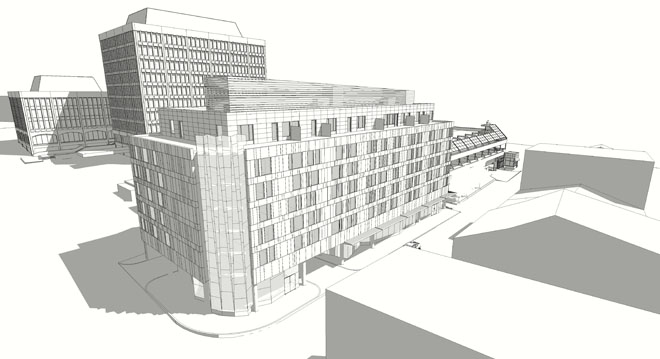Visual Language
AIA DESIGN THEORY – November, 2012
Edited by Rebecca Falzano | Photography Trent Bell
Patrick Costin on the marriage of art and science in architecture.
At its heart, the practice of architecture demands an in-depth knowledge of technical principles. Yet very few of us would walk into Gaudi’s La Sagrada Familia or Wright’s Fallingwater and immediately begin thinking about scientific calculations and engineering formulae. Instead, our reactions to truly stunning buildings are ones of awe, inspiration, and even enlightenment. These two elements, art and science, are so essential and inextricable that the best architects must have an intuitive command of both. Patrick Costin, cofounder of Canal 5 Studio in Portland, explains to MH+D how the best kind of architecture unites these elements.
Q: What is your definition of an “artistic” piece of architecture?
A: I believe architecture is about creating buildings that resonate with people on an emotional and energetic level. Buildings have the inherent potential to raise our spiritual state and to open our hearts to beauty. What interests me is how difficult it is to achieve that idealistic goal—one reason why so many built spaces are pedestrian and uninspiring.
For me, a great building is one that gives people a positive intuitive reaction. People may not see the underlying “grammar” of a building, but they do sense the overall emotional impact of the space. When architects use the grammar well, we can make people feel the force of humanity, we can lift them up, and we can imprint powerful memories. One of the strengths of our firm is that, while my colleagues and I approach our design work from very different backgrounds, in the end what we’re all looking for is to speak with our buildings, to find a visual language that is more poetic than prosaic, and to tap into an inherent aesthetic sensibility.
I believe buildings hold and impart energy, just like people do. Being able to choreograph that energy is what we strive to do. I try to perceive how a building would feel and how it would make an occupant feel. Something as simple as color, for example, has the ability to shape a person’s experience as they move through a built environment, and affect how they feel and how they relate to the world at that moment in time. Our job is to cultivate the most resonant version of that experience. A client once told me, “All I know is that I feel good when I walk into the building.” I’ve never received a higher compliment.
Q: Do you feel, then, that “science” inhibits your creativity?
A: Not at all. In fact, the scientific and technical elements provide us with the groundwork upon which we build our aesthetic vision. After all, we have to be able to translate our creative, abstract insights into executable terms that others can use.
Some might think of great architecture as being produced by a lone genius, but in reality the practice of architecture requires a team of diverse participants and the architect coordinating them like the conductor of a symphony, with the client, consultants, engineers, and vendors each playing their individual parts. We do that by translating ideas and abstract concepts into the scientific terms that engineers and construction specialists need in order to execute the building.
So, in a sense, the whole process begins and ends with a scientific approach. Science aids us in solidifying our entire design and construction process. We seek inspiration, first and foremost, by thoroughly understanding the unique technical context in which each project is grounded. Through research and dialogue, we seek clarity as to how the human and material requirements will lay the foundation for the project’s development. Upon that foundation we can build the artistic vision.
Q: How do clients benefit from this duality—your own inspired artistic vision combined with the perhaps less-inspiring science and technology that your work requires?
A: The art of architecture is about creating buildings that resonate deeply with the human spirit. The science of architecture discerns the frame of reference for an enduring piece of architecture.
For each project, we act as counselors to our clients, guiding them through this complex process. In order to optimize the value we create for them, we have to ensure that we have a firm grasp of their program, scope, schedule, and budget from the very beginning.
Whether we are designing a house or a complex institutional building, we invest time in thoroughly understanding the cultural context our design will frame. Using this research, we can design buildings that support and engage human interaction at its highest potential. Without this understanding, we will miss the mark completely—and the artistry will never come to fruition.
The essential question for us is always the same, however: what is the true purpose of the building, and how can we transcend its use to leave something of enduring beauty?


